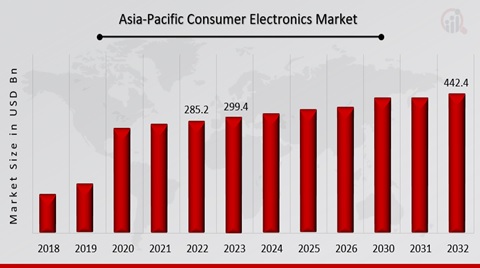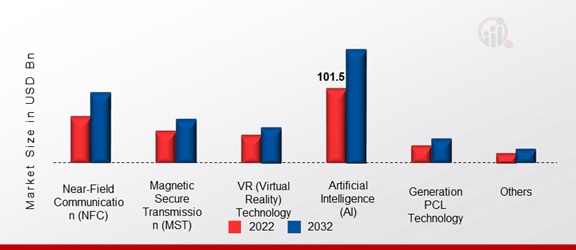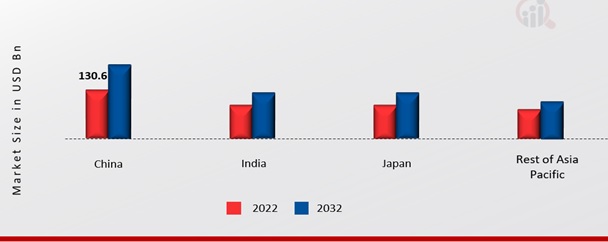Asia Pacific Consumer Electronics Market Overview
Asia-Pacific Consumer Electronics Market Size was valued at USD 285.2 Billion in 2022. The Consumer Electronics market industry is projected to grow from USD 299.4 Billion in 2023 to USD 442.4 Billion by 2032, exhibiting a compound annual growth rate (CAGR) of 5.00% during the forecast period (2024 - 2032). The growing urbanization is one of the major market drivers driving the consumer electronics market in Asia-Pacific.

Source: Secondary Research, Primary Research, MRFR Database and Analyst Review
APAC Consumer Electronics Market Trends
-
Growing 5G technology integration is driving market growth
The Asia-Pacific Consumer Electronics market CAGR is expanding because Faster downloads, smoother streaming, and enhanced user experiences are all made possible by 5G networks' much faster data speeds than their 4G/LTE predecessors. This speed increase is especially important for consumer electronics applications that require a lot of data. The reduced latency of 5G networks makes it possible for devices to communicate almost instantly with one another. To give users a more responsive and engaging experience, this is crucial for apps like augmented reality (AR), virtual reality (VR), online gaming, and other real-time services. 5G facilitates the growth of the Internet of Things (IoT) by enabling a larger density of connected devices per square kilometer. This is especially important in smart cities and homes, where many gadgets are connected. Better mobile broadband services benefit consumers in the Asia-Pacific region by enabling better connectivity on smartphones, tablets, and other portable devices. Particularly in highly populated urban areas, this is crucial.
Additionally, smart appliance adoption is aided by the growing trend of connected homes worldwide. Because they are more convenient, appliances with voice help, Bluetooth, and Wi-Fi connectivity are becoming more popular. Players are attempting to pack as many functions as possible into their gadgets to draw in customers. For instance, Actions Technology Co., Ltd. and Boat, an Indian electronics firm, worked to introduce the "Stone 1200," a line of smart speakers that can pair via Bluetooth with smartphones, in August 2021. The growing popularity of smart gadgets and the pace of technical improvements will probably drive the expansion of the consumer electronics sector. Thus, driving the Asia-Pacific Consumer Electronics market revenue.
Asia-Pacific Consumer Electronics Market Segment Insights
-
Consumer Electronics Product Insights
Based on Product, the Asia-Pacific Consumer Electronics market segmentation includes smartphones, desktops, tablets, laptops & notebooks, digital cameras, e-readers, HDD, televisions, refrigerators, washing machines, air conditioners, and others. The smartphones segment dominated the market. The main drivers of this segment's growth are the rising acceptance of the Product, the growing popularity of smartphones among consumers globally, and manufacturer improvements. The three main operating systems that control the international smartphone market are Windows, iOS, and Android. The emergence of compact and affordable cell phones and their multifunctional characteristics has propelled this segment's expansion. Throughout the projection period, this segment's rise is anticipated to be further propelled by the developing world's growing need for smartphones. Additionally, the rapid advancements in the IT and telecommunications infrastructure, coupled with the introduction of 4G and 5G technologies, are anticipated to have a major effect on market growth.
The desktop segment is expected to grow the fastest. The APAC region has a significant gaming culture, and enthusiasts demand gaming desktops with high-performance specs. Strong desktop PCs are in demand due in part to the expansion of the gaming sector. Desktop computers are popular among professionals in content production fields, including graphic design, video editing, and 3D modeling, because of their powerful processors and easy component upgrades.
-
Consumer Electronics Distribution Channel Insights
Based on the Distribution Channel, the segmentation of Asia-Pacific Consumer Electronics includes online, e-commerce websites, company-owned websites, offline, hypermarkets & supermarkets, departmental stores, and specialty stores. The offline category generated the most income. Due to the possibility of receiving immediate satisfaction and the support of knowledgeable salespersons throughout the purchase, most customers are increasingly choosing to acquire electronic devices through offline channels.
The online category is predicted to have the quickest rate. The primary drivers of the online segment's growth are the quick development of the IT and telecommunications infrastructure, the growing popularity of smartphones, the penetration of online shopping platforms, and the dramatically rising number of internet users. Online retailers attract customers by offering more products and brands, flexible payment methods, simple return and exchange policies, speedy home delivery, and round-the-clock customer support.
-
Consumer Electronics Application Insights
Based on Application, the segmentation of Asia-Pacific Consumer Electronics includes personal and professional. The personal category raked in the highest revenue. The category of personal applications includes wearable Technology, such as fitness trackers and smartwatches. These gadgets detect physical activity, check health data, and send notifications.
The fastest rate is anticipated for the professional category. This is due to ultrabooks and laptops of the highest quality for use in the office, equipped with cutting-edge features and powerful performance for productivity and business use.
-
Consumer Electronics Type Insights
Based on Type, the segmentation of Asia-Pacific Consumer Electronics includes conventional and smart. The conventional segment generated the most revenue despite constant advancements in technologies like 4K and smart features; traditional television sets remain standard in the consumer electronics industry. Stereo systems, home theater configurations, and standalone speakers are conventional audio systems often used for entertainment.
The smart category is predicted to have the quickest rate. Connectivity features in door locks allow for interaction with smart home systems and remote locking and unlocking via mobile apps. Cars with clever features like connected infotainment systems, sophisticated infotainment systems, and occasionally autonomous driving capabilities.
-
Consumer Electronics Technology Insights
Based on Technology, the segmentation of Asia-Pacific Consumer Electronics includes Near-Field Communication (NFC), Magnetic Secure Transmission (MST), Artificial Intelligence (AI), VR (Virtual Reality) Technology, Generation PCL Technology, and others. The category that produced the highest revenue was artificial intelligence (AI). APAC consumer electronics companies use artificial intelligence (AI) to improve customer assistance and engagement with chatbots, virtual assistants, and automated customer service systems.
The near-field communication (NFC) segment is estimated to have the greatest rate. Mobile payment solutions using Near Field Communication (NFC) enable users to safely complete transactions at point-of-sale terminals by tapping their wearables or smartphones. Several local platforms and well-known mobile payment services like Apple Pay and Google Pay use NFC technology.
Figure 1: Asia-Pacific Consumer Electronics Market, by Technology, 2022 & 2032 (USD Billion)

Source: Secondary Research, Primary Research, MRFR Database and Analyst Review
Consumer Electronics Country Insights
The largest market share is expected to be in China. China has a sizable population with rising disposable incomes, which drives the country's enormous consumer electronics sector. The smartphone market is extremely competitive, with prominent local brands Oppo, Xiaomi, and Huawei. Devices like wearables, tablets, and smartphones are all manufactured in large quantities in China. 5G technology, smart home solutions, and Internet of Things devices are in high demand. China's economy is being propelled by the rising expenditures of this generation as well as an increase in commerce in consumer electronics. The affluent upper-middle class in China will create opportunities for sales for the well-known companies already in the market, which is generally good news for Chinese producers of consumer electronics.
Figure 2: Asia-Pacific Consumer Electronics MARKET SHARE BY Country 2022 & 2032 (USD Billion)

Source: Secondary Research, Primary Research, MRFR Database and Analyst Review
APAC Consumer Electronics Key Market Players & Competitive Insights
Prominent industry participants are making significant R&D investments to broaden their range of products, contributing to the market expansion for Consumer Electronics. In addition, market players are engaging in various strategic endeavors to broaden their market reach. Significant developments include introducing new products, contractual arrangements, mergers and acquisitions, increased investment levels, and cooperation with other entities. The Consumer Electronics sector must provide affordable products to grow and endure in an increasingly cutthroat and dynamic marketplace.
Businesses engaged in research and development are trying to boost demand for Consumer Electronics from major participants in the market, including Canon Inc., Sony Corporation, Lenovo Inc., Samsung Electronics Co., Ltd., Panasonic Corporation, Hewlett-Packard Company, Koninklijke Philips N.V., Oneplus, Sennheiser Electronics, OPPO, LG Corporation, Hitachi Ltd., and ZTE Corporation.
Key Companies in the Consumer Electronics market include
- Canon Inc.
- Sony Corporation
- Lenovo Inc.
- Samsung Electronics Co., Ltd.
- Panasonic Corporation
- Hewlett-Packard Company
- Koninklijke Philips N.V.
- Oneplus
- Sennheiser Electronics
- OPPO
- LG Corporation
- Hitachi Ltd.
- ZTE Corporation
APAC Consumer Electronics Industry Developments
May 2023: The "Xperia 1V" smartphone, which features a CMOS image sensor with two-layer transistor pixels, was introduced by Sony Electronics Inc.
December 2022: LG Electronics introduced the "LG ThinQ UP" line of cutting-edge household appliances, which includes ovens, dishwashers, washers, dryers, and refrigerators. These goods provide clever and perceptive features that can satisfy customers' expanding needs.
Asia-Pacific Consumer Electronics Market Segmentation
APAC Consumer Electronics Product Outlook
- Smartphones
- Desktops
- Tablets
- Laptops & Notebooks
- Digital Cameras
- eReaders
- HDD
- Television
- Refrigerators
- Washing machine
- Air Conditioners
- Others
APAC Consumer Electronics Distribution Channel Outlook
- Online
- E-Commerce Websites
- Company-Owned Websites
- Offline
- Hypermarkets & Supermarkets
- Departmental Stores
- Specialty Stores
APAC Consumer Electronics Application Outlook
APAC Consumer Electronics Type Outlook
APAC Consumer Electronics Technology Outlook
- Near Field Communication (NFC)
- Magnetic Secure Transmission (MST)
- Artificial Intelligence (AI)
- VR (Virtual Reality) Technology
- Generation PCL Technology
- Others
APAC Consumer Electronics Regional Outlook
- APAC
- China
- Japan
- India
- Australia
- South Korea
- Indonesia
- Thailand
- Vietnam
- Malaysia
- Singapore
- Rest of Asia-Pacific
| Report Attribute/Metric |
Details |
| Market Size 2022 |
USD 285.2 Billion |
| Market Size 2023 |
USD 299.4 Billion |
| Market Size 2032 |
USD 442.4 Billion |
| Compound Annual Growth Rate (CAGR) |
5.00% (2024-2032) |
| Base Year |
2023 |
| Market Forecast Period |
2024-2032 |
| Historical Data |
2018- 2022 |
| Market Forecast Units |
Value (USD Billion) |
| Report Coverage |
Revenue Forecast, Market Competitive Landscape, Growth Factors, and Trends |
| Segments Covered |
Product, Distribution Channel, Application, Type, Technology, and Region |
| Region Covered |
Asia-Pacific |
| Countries Covered |
China, Japan, India, Australia, South Korea, Indonesia, Thailand, Vietnam, Malaysia, Singapore, Rest of Asia-Pacific |
| Key Companies Profiled |
Canon Inc., Sony Corporation, Lenovo Inc., Samsung Electronics Co., Ltd., Panasonic Corporation, Hewlett-Packard Company, Koninklijke Philips N.V., Oneplus, Sennheiser Electronics, OPPO, LG Corporation, Hitachi Ltd., and ZTE Corporation |
| Key Market Opportunities |
· Internet of Things (IoT) integration in electronics and new businesses · Rise in development and expenditure |
| Key Market Dynamics |
· Growing urbanization · Beneficial government initiative |
Frequently Asked Questions (FAQ) :
The Asia-Pacific Consumer Electronics market size was valued at USD 285.2 Billion in 2022.
The market is projected to grow at a CAGR of 5.00% during the forecast period, 2024-2032.
The key players in the market are Canon Inc., Sony Corporation, Lenovo Inc., Samsung Electronics Co., Ltd., Panasonic Corporation, Hewlett-Packard Company, Koninklijke Philips N.V., Oneplus, Sennheiser Electronics, OPPO, LG Corporation, Hitachi Ltd., and ZTE Corporation, among others.
The Smartphones category dominated the market in 2022.
The Offline category had the largest share of the market.





























